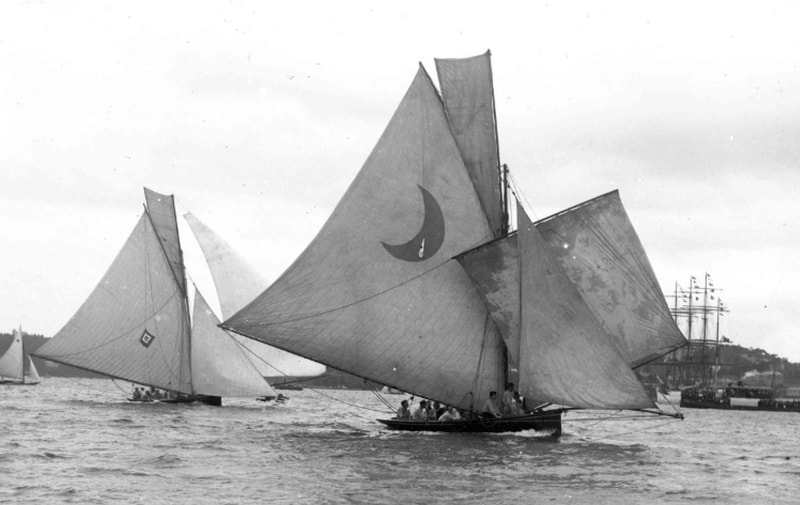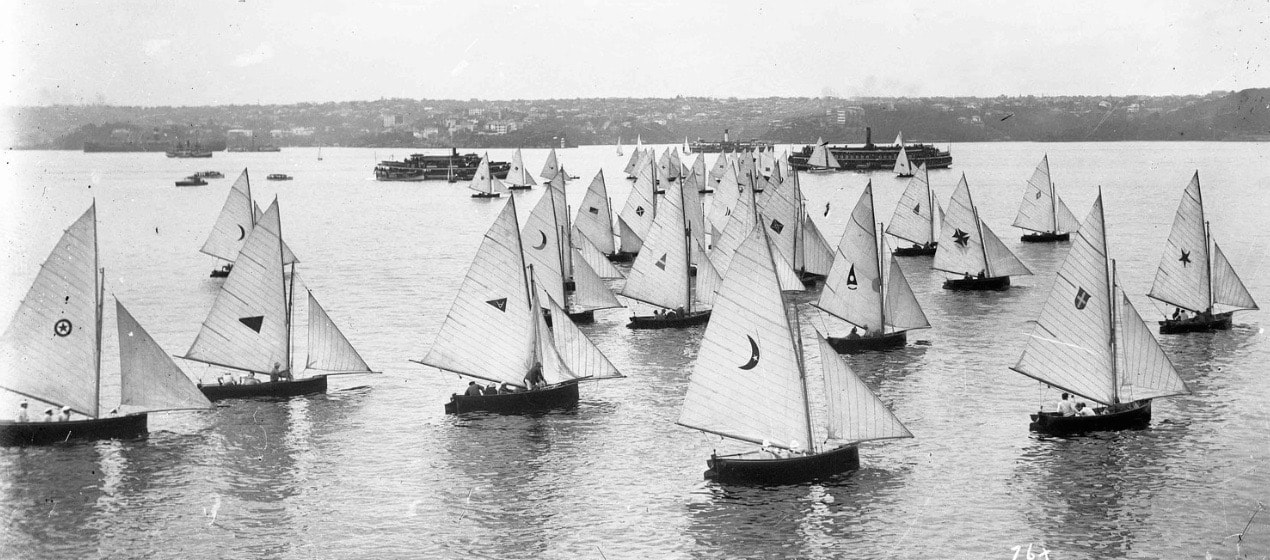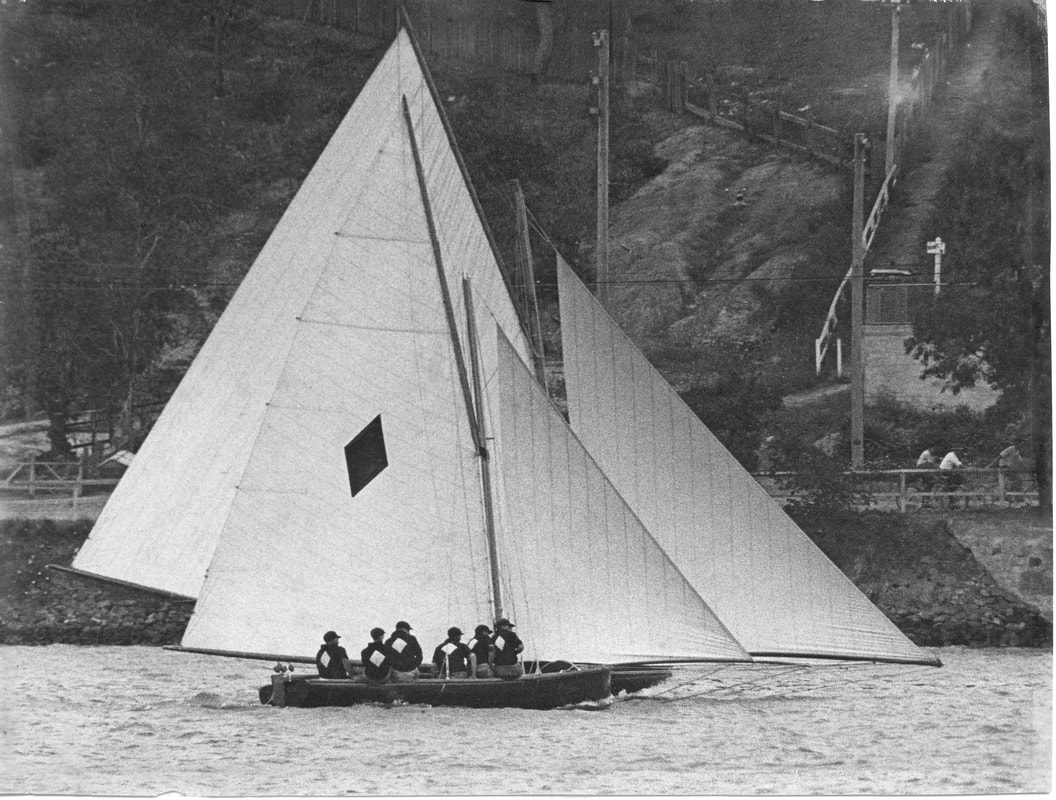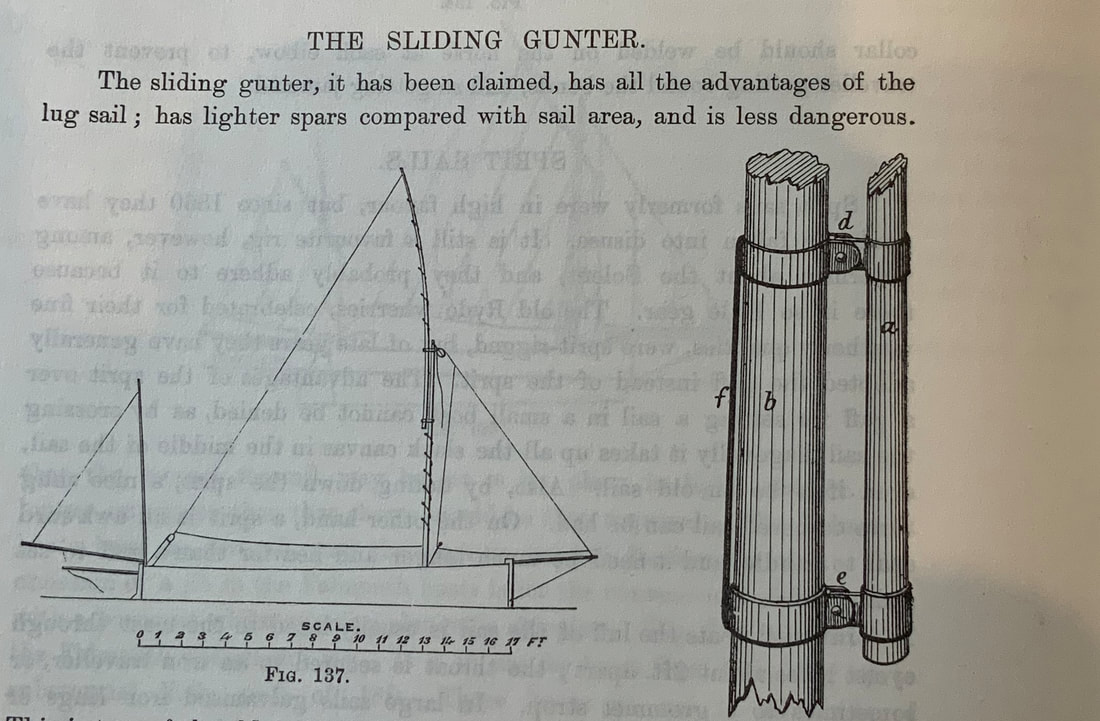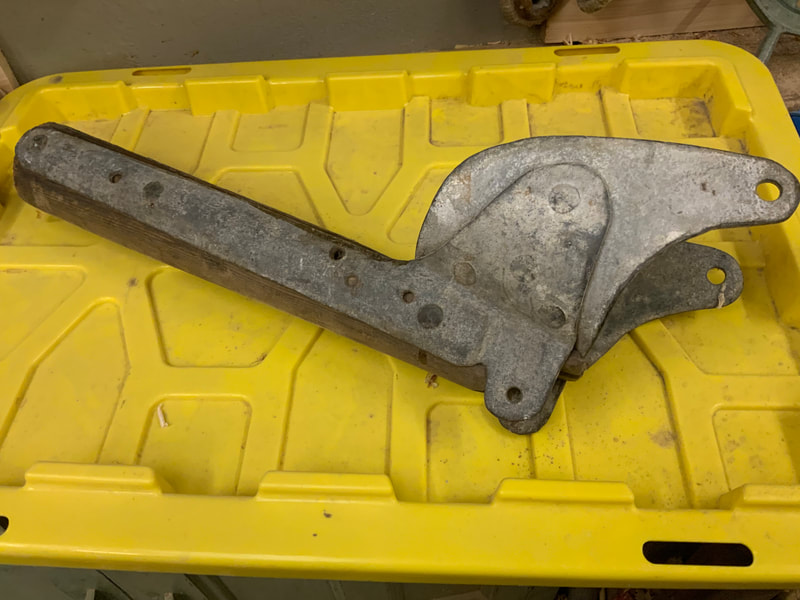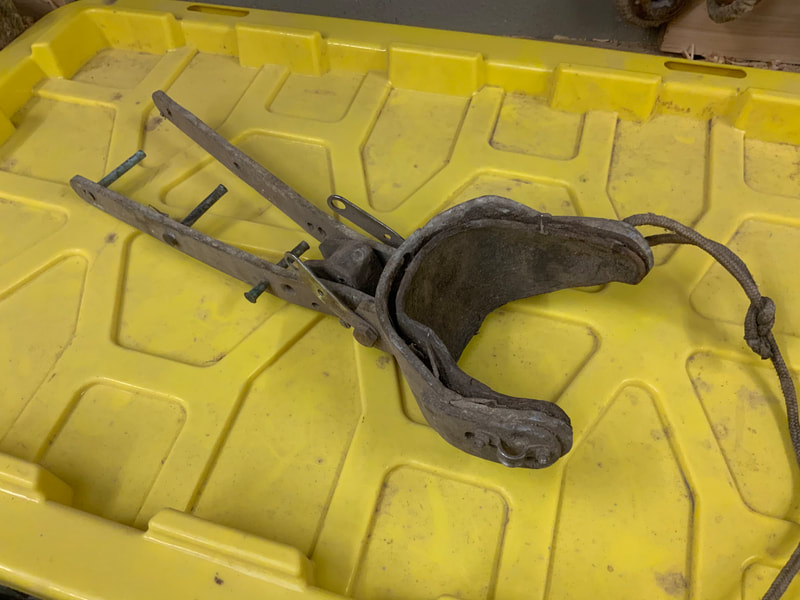Aussie skiffs' high-peaked gaff rigs have sometimes been referred to as gunter rigs. Ian Smith finds out where this came from and attempts to find the line between gaff and gunter, but is there one?
Gaff rigs on Australian open racing boats were always fairly high-peaked, certainly more highly-peaked than yachts of the same time, best shown by the narrow tops’ls that became the norm on the twenty-two footers of the late 1890’s and the developing class of 18-footers that copied most of their features.
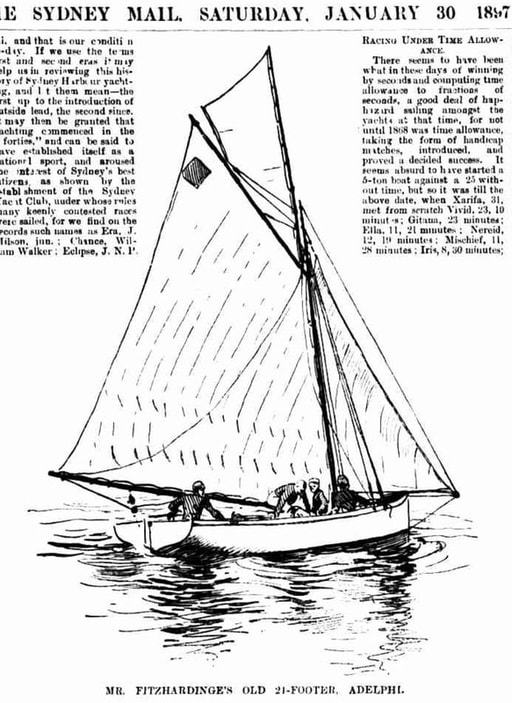
The early 24-footers of the 1870's like Adelphi had gaffs that were beginning to peak up higher than yachts of their time, and most later classes of yachts like the 30' linear racers like Culwalla in the first decade of the 20th Century never got much higher than this.
Left: 1870's 24-footer Adelphi pictured in the Sydney Mail, Jan 30 1897, found on Trove NLA.
Left: 1870's 24-footer Adelphi pictured in the Sydney Mail, Jan 30 1897, found on Trove NLA.
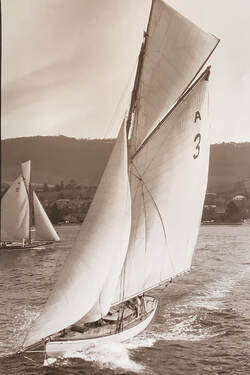
Right: Culwalla, a Logan-built 30' linear rater from 1901, still survives as Yeulba, awaiting restoration.
Above left: The 22-footers like Vuna and Wonga had developed high-peaked gaffs by the late 1890's that carried distinctive narrow tops'ls that were also carried by the 18-footers that supplanted them, as on HC Press, above right seen here in the 1920's. Left image from Hall Collection ANMM, right image from Harry Thompson Collection Sydney Flying Squadron.
In 1901 a new class of restricted 16’ skiffs began racing in Sydney with rules that standardised for the second season with limits to beam (5’3”), crew (3) and boom length (14’). Commentators after this second season pointed out that the limited boom length was leading to freak rigs, with at least one lateen rig and several high aspect ratio lugs’ls. Most of the fleet however made longer gaffs and peaked them up quite high, higher than the other classes had done. Most of the sails appear to have been made at the same loft, Dingwall’s in Balmain and were cut with cloths square to the leech instead of parallel to the leech as was the rule in the 18’s, and utilised full-length battens above the throat. For the third season a sail area limit of 220 sq ft was introduced, and the high-peaked mains became quite standardised with little further change until the mid-1950’s.
Above: The 16-footer fleet in the 1920's showing their distinctive and almost identical rigs that were sometimes referred to as gunter rigs, and showed little change from the early 1900's to the mid-1950's. Hall Collection ANMM.
The 12-footer class which evolved in the 1920’s also adopted the 16-footer-style rigs. The 18’s carried on with their not quite so high-peaked sails. But when Brisbane boatbuilder and National 16-footer Champion Toby Whereat built the 18-ft Aberdare on skiff lines in 1932, he used a scaled-up 16-footer rig with high-peaked gaff and full battens. The story has been told many times (see Elliott’s Galloping Ghosts 2012 and Smith’s The Open Boat 2017) but Aberdare’s success meant that within a few years every new boat was using the 16-footer-type mains’ls.
A great shot of the skiff-type rig of Aberdare over the old-style rig of Tangalooma, about 1933. Sydney Flying Squadron Collection.
As far as I can determine searching contemporary newspapers the rigs were mostly referred to as gaff rigs, or actually as just skiff rigs at the time. But there are occasional references to gunter rigs, the earliest in the period discussed being in The Town and Country Journal of 23 Feb 1904 where the 16-footer Cutty Sark was referred to as having gunter rig. Both gaff and gunter are used almost interchangeably (one writer uses both in the one article) throughout the 1920’s and ‘30’s, with gaff having the edge, and gunter used mostly when making a point about the difference between the 18’ and the 16’s. In Seacraft magazine of September 1948 Bryce Mortlock has an article on “The Evolution of the 16-Footer” where he describes the “now ubiquitous sliding gunter rig” displacing the lugs’ls that a few of the original boats carried. The spar itself was always referred to as the gaff rather than a yard. Other classes such as sailing canoes were described as having gunter rigs (usually of bamboo), and the high-peaked gaffs of the 21ft Restricted racing boats of the 1920’s-1950’s led to some writers, but not all, describing them as having gunter rigs.
Where did gunter rig come from?
The principle of the sliding gunter seems to have been developed in ships’ boats and other workboats in the early decades of the 19th Century. The principle was to make the mast telescopic. The sliding gunter or gunter iron was the name of the metal fabrication illustrated below, two conjoined figure 8’s with the heel of the yard as it was referred to in the aft pair, and the other pair sliding on the mast, hauled up by a single halyard. The name appears to have come from English mathematician Edmund Gunter (1581-1626) who invented the Gunter Scale, a predecessor of the slide rule, where one part slid against the other. The device was familiar to seamen as a navigational instrument and known to them as a gunter and when the sliding yard was developed the name gunter rig was applied to it.
Where did gunter rig come from?
The principle of the sliding gunter seems to have been developed in ships’ boats and other workboats in the early decades of the 19th Century. The principle was to make the mast telescopic. The sliding gunter or gunter iron was the name of the metal fabrication illustrated below, two conjoined figure 8’s with the heel of the yard as it was referred to in the aft pair, and the other pair sliding on the mast, hauled up by a single halyard. The name appears to have come from English mathematician Edmund Gunter (1581-1626) who invented the Gunter Scale, a predecessor of the slide rule, where one part slid against the other. The device was familiar to seamen as a navigational instrument and known to them as a gunter and when the sliding yard was developed the name gunter rig was applied to it.
The sliding Gunter illustrated in Dixon Kemp's Manual of Yacht and Boat Sailing (1894).
Sliding gunter rigs are regularly mentioned in advertisements for the sale of working boats from the 1830’s to the 1850’s. In the late 1830’s local yachting pioneer James Milson bought a gunter-rigged workboat named Friendship with a reputation for speed built by George Green and began to race it as a first-class yacht. The picture below suggests that he rigged it with stays over spreaders near the masthead. As far as I can tell it was the only yacht of the time to be gunter-rigged, and after a few seasons it was converted to a gaff cutter. Sliding gunter rigs were described by writers later in the 19th Century as going out of fashion in the 1850’s.
Gunter-rigged yacht Friendship, late 1830's. Trove NLA.
When the term gunter rig began to be revived after 1900 it was generally used to describe high-peaked gaff rigs. The fact that some people were using the terms interchangeably led some people with tidy minds to begin to try to define them. It is clear that the sliding gunter rigs of the 19th Century were indisputably gunter-rigged, but those who might insist that only rigs with a sliding gunter iron are gunter rigs ignores more than a century of alternate usage. Many intended definers wanted to describe any high-peaked gaff as gunter rigged as was commonly done, but no one could come up with an agreed angle which separated gaff from gunter. Others insisted that it was only gunter rig if the yard was exactly parallel with the mast, as in the rigs of the early to mid-19th Century, and the sail was cut so the leading edge of the sail on the yard was parallel with the luff on the mast, even though set back a little to allow for the yard. Others have suggested that it is gunter rigged if the spar goes up on just one halyard rather than separate throat and peak halyards. Both of these two definitions rule out the very boats we are talking about, the 16- and 18-footers which have often been referred to as gunter-rigged, so I find all of these definitions unsatisfactory on the grounds that ruling out a fairly common and long-standing usage is not helpful.
A more recent definition I have come across is that it is a gunter rig if the yard or gaff is not able to tilt back to be lowered. This certainly applies to the original sliding gunters, but it is determined by how the lower end of the gaff or yard is attached to the mast. Most 16-footers had fixed jaws (always referred to as gaff jaws) that when lashed to the mast only allowed the gaff to be tilted back a little so that they needed to drop the gaff almost vertically when lowering away. Most 18-footers had similar jaws even on the earlier boats with not quite so high-peaked rigs. When waiting under Clark Island for racing to start, 18-footers would de-power their sails by hoisting up the boom rather than lowering the gaff. It was common to lower away when confronted by approaching squalls, but the gaff could be tilted back only when the jaws were low enough on the mast for a crewman to undo the lashing on the front of the jaws. Some designs for 18-footer jaws did allow a fair amount of tilt back as pictured below, and as on the original and replica Britannia.
And even some 16-footers could tilt the gaff back. In my collection I have a set of late 1940’s or early 1950’s 16-footer gaff jaws from 16-footer legend Jack Ray’s collection which are modelled on a yacht-style gaff saddle which allows the gaff to drop to horizontal and beyond.
A more recent definition I have come across is that it is a gunter rig if the yard or gaff is not able to tilt back to be lowered. This certainly applies to the original sliding gunters, but it is determined by how the lower end of the gaff or yard is attached to the mast. Most 16-footers had fixed jaws (always referred to as gaff jaws) that when lashed to the mast only allowed the gaff to be tilted back a little so that they needed to drop the gaff almost vertically when lowering away. Most 18-footers had similar jaws even on the earlier boats with not quite so high-peaked rigs. When waiting under Clark Island for racing to start, 18-footers would de-power their sails by hoisting up the boom rather than lowering the gaff. It was common to lower away when confronted by approaching squalls, but the gaff could be tilted back only when the jaws were low enough on the mast for a crewman to undo the lashing on the front of the jaws. Some designs for 18-footer jaws did allow a fair amount of tilt back as pictured below, and as on the original and replica Britannia.
And even some 16-footers could tilt the gaff back. In my collection I have a set of late 1940’s or early 1950’s 16-footer gaff jaws from 16-footer legend Jack Ray’s collection which are modelled on a yacht-style gaff saddle which allows the gaff to drop to horizontal and beyond.
Left: a much-used type of 16-footer gaff jaws, usually cast in aluminium. Gaffs had to be kept fairly upright while lowering until the lashing could be eased. Centre: 1940's 18-footer gaff jaws. Right: Early 1950's 16-footer gaff saddle that allowed tilting the gaff back to horizontal.
So the only definitions of gunter rig which are well, definitive, are those which involve the use of a sliding gunter, and those that have the yard parallel with the mast. The definitions that will include only those that cannot lay the yard back, and more commonly those with high-peaked gaffs have too many grey areas.
But usage determines meaning, so seeing high-peaked gaff rigs have been referred to as gunter rigs for more than a century (but not by everybody) and if a whole bunch of people know what you’re talking about when you refer to a high-peaked gaff as a gunter, so be it, and it can be quite useful when comparing rigs. But if you insist that a high-peaked gaff rig should never be referred to as gunter rig, or that it can only be referred to as gunter-rigged you are a dangerous pedant and probably a bar-clearer.
But usage determines meaning, so seeing high-peaked gaff rigs have been referred to as gunter rigs for more than a century (but not by everybody) and if a whole bunch of people know what you’re talking about when you refer to a high-peaked gaff as a gunter, so be it, and it can be quite useful when comparing rigs. But if you insist that a high-peaked gaff rig should never be referred to as gunter rig, or that it can only be referred to as gunter-rigged you are a dangerous pedant and probably a bar-clearer.
